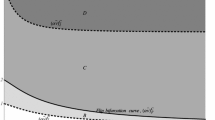Abstract
We combine Hotelling’s model of product differentiation with tie-in sales. A monopolist in one market competes with another firm in a second market. In equilibrium firms choose zero product differentiation. Due to the tying structure no firm can gain the whole market by a small price reduction. A differentiation effect due to tie-in sales leads to this equilibrium stability.
Similar content being viewed by others
References
Adams W.J., Yellen J.L. (1976). Commodity bundling and the burden of monopoly. The Quarterly Journal of Economics 90, 475–498
D’Aspremont C., Gabszewicz J.J., Thisse J.-F. (1979). On Hotelling’s “Stability in Competition”. Econometrica 47, 1145–1150
Burstein M.L. (1960). The economics of tie-in sales. The Review of Economics and Statistics 42, 68–73
Burstein M.L. (1988). A theory of full line forcing. In: Burstein M.L.(ed) Studies in banking theory, financial history and vertical control. New York, St. Martin’s Press, pp. 156–192
Böckem S. (1994). A generalized model of horizontal product differentiation. The Journal of Industrial Economics 42, 287–298
Carbajo J., de Meza D., Seidmann D.J. (1990). A strategic motivation for commodity bundling. The Journal of Industrial Economics 38, 283–298
Economides N. (1984). The principle of minimum differentiation revisited. European Economic Review 24, 345–368
Hinloopen J., van Marrewijk C. (1999). On the limits and possibilities of the principle of minimum differentiation. International Journal of Industrial Organization 17, 735–750
Hotelling H. (1929). Stability in competition. The Economic Journal 39, 41–57
Martin S. (1999). Strategic and welfare implications of bundling. Economics Letters 62, 371–376
Neven D., Thisse J.-F. (1990). On quality and variety competition. In: Gabszewicz J.J., Richard J.-F., Wolsey L.A.(eds) Economic decision-making: Games, econometrics, and optimization. Amsterdam, North-Holland, pp. 175–199
Wang X.H., Yang B.Z. (1999). On Hotelling’s location model with a restricted reservation price. Australian Economic Papers 38, 259–275
Whinston M.D. (1990). Tying, foreclosure, and exclusion. American Economic Review 80, 837–859
Author information
Authors and Affiliations
Corresponding author
Rights and permissions
About this article
Cite this article
Egli, A. On Stability in Competition: Tying and Horizontal Product Differentiation. Rev Ind Organ 30, 29–38 (2007). https://doi.org/10.1007/s11151-007-9127-y
Published:
Issue Date:
DOI: https://doi.org/10.1007/s11151-007-9127-y




